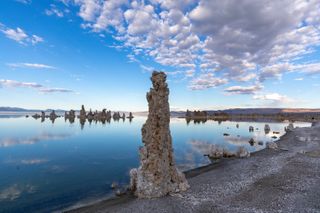Early 'Soda Lakes' May Have Provided Missing Ingredient Key to the Origin of Life
This mineral was scarce yet necessary for early life.

The first life-forms on Earth needed a pu pu platter of ingredients to exist, but one of those ingredients, the mineral phosphorus, has long puzzled scientists. No one knew how phosphorus, one of the six main chemical elements of life, became plentiful enough on early Earth for life to burst forth.
Now, researchers may have the answer; lakes that thrived in dry locations on early Earth likely played a key role in supplying phosphorus, researchers wrote in a new study published Dec. 30 in the journal Proceedings of the National Academy of Sciences.
The finding explains how this scarce mineral became abundant in Earth's primordial soup. Put more plainly, it helps scientists understand how life likely arose. "For 50 years, what's called 'the phosphate problem,' has plagued studies on the origin of life," study co-researcher Jonathan Toner, a research assistant professor of Earth and space sciences at the University of Washington, said in a statement.
Related: 7 Theories on the Origin of Life
Phosphorus is crucial to life as we know it. The mineral helps form the backbone of DNA and RNA molecules; anchors lipids, or fats, that separate cells from the environment around them; and helps provide life energy, serving as the main component in molecules such as adenosine triphosphate, or ATP.
To investigate the "phosphate problem," the researchers in the new study looked at carbonate-rich lakes, which are found in dry environments. These lakes, also known as soda lakes, form when water from the surrounding landscape flows into a depression. Evaporation then turns the lake water salty and alkaline (meaning it has a high pH).
The researchers took phosphorus measurements in soda lakes all around the world, including in California's Mono and Searles lakes, Kenya's Lake Magadi, and India's Lonar Lake.
Sign up for the Live Science daily newsletter now
Get the world’s most fascinating discoveries delivered straight to your inbox.
While the phosphorus concentrations varied by season, these carbonate-rich lakes had up to 50,000 times more phosphorus than is found in seawater, rivers and other types of lakes, according to Toner and study co-researcher David Catling, a professor of Earth and space sciences at the University of Washington.
These high concentrations suggested that a natural process allowed phosphorus to accumulate in these lakes, the researchers said. However, it was hard to experiment on the lakes themselves, because they host a splendid array of animals that affect the chemical composition of each lake. Africa's Lake Magadi, for instance, is home to a famous flock of flamingos.

To understand how a lifeless lake could give rise to life, the researchers experimented on carbonate-rich water in bottles.
The team noted that, because of their carbonate content, soda lakes have high phosphorus levels. Normally, calcium in lakes binds to phosphorus to make solid minerals of calcium phosphate, that make their constituent minerals inaccessible to life. But in lakes with high carbonate levels, carbonate outcompetes phosphate in binding to calcium. As a result, some of the phosphate is freely available in the water, according to experiments done by Toner and Catling.
"It's a straightforward idea, which is its appeal," Toner said. "It solves the phosphate problem in an elegant and plausible way."
'Tis the season
During dry seasons, phosphate levels can spike in soda lakes, meaning these bodies can have phosphate levels 1 million times higher than those in seawater.
"The extremely high phosphate levels in these lakes and ponds would have driven reactions that put phosphorus into the molecular building blocks of RNA, proteins and fats, all of which were needed to get life going," Catling said in the statement.
Related: In Images: The Oldest Fossils on Earth
About 4 billion years ago, early Earth's carbon dioxide-rich air would have helped create such lakes with high phosphorus levels, the researchers said. That's because carbonate-rich lakes often form where atmospheres have high carbon dioxide levels. Furthermore, carbon dioxide dissolves in water, making it more acidic, which in turn releases phosphorus from rocks.
"The early Earth was a volcanically active place, so you would have had lots of fresh volcanic rock reacting with carbon dioxide and supplying carbonate and phosphorus to lakes," Toner said. "The early Earth could have hosted many carbonate-rich lakes, which would have had high enough phosphorus concentrations to get life started."
This study complements another paper the two researchers published in 2019, which shows that soda lakes can also supply ample cyanide, a chemical that is deadly to humans but not to primitive microbes. Cyanide could have supported the formation of amino acids and nucleotides, the building blocks of proteins, DNA and RNA — in essence, the key ingredients of life, the researchers said.
- What Was the First Life on Earth?
- How the First Life on Earth Struggled to Survive
- How Did Life Arise on Earth?
Originally published on Live Science.


Laura is the archaeology and Life's Little Mysteries editor at Live Science. She also reports on general science, including paleontology. Her work has appeared in The New York Times, Scholastic, Popular Science and Spectrum, a site on autism research. She has won multiple awards from the Society of Professional Journalists and the Washington Newspaper Publishers Association for her reporting at a weekly newspaper near Seattle. Laura holds a bachelor's degree in English literature and psychology from Washington University in St. Louis and a master's degree in science writing from NYU.